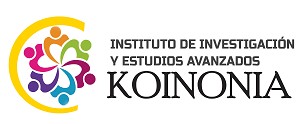La lógica difusa como herramienta para la evaluación del desempeño de los servidores públicos
Resumen
Uno de los elementos de la gestión del talento humano, es la evaluación de desempeño, que, para el caso de los servidores públicos, constituye uno de los temas de mayor importancia en las Instituciones del Estado. La unidad de análisis de la presente investigación es la Dirección Zonal 6 del SRI en la ciudad de Cuenca, en donde se identificó que existe una afectación en el clima laboral procedente de resultados de evaluaciones de desempeño deficientes. Se propone una metodología de avanzada dentro de la lógica difusa, que es la teoría de los efectos olvidados, a fin de valorar los elementos o variables que inciden en los resultados del proceso de evaluación de desempeño, y que, a pesar de que se tenga un buen sistema de control, siempre existe la posibilidad de no considerar, u olvidar algunas relaciones de causalidad que no siempre resultan explicitas o evidentes, y que provoca que normalmente no sean considerados dentro de este proceso. La investigación fue de tipo no experimental, cuali-cuantitativa, tiene un alcance descriptivo y de finalidad transversal. Como resultado más relevante se determinó que la variable omitida es la elaboración de un óptimo instrumento de evaluación.
Descargas
Citas
2. Alles, M. (2013). Dirección Estratégica de Recursos Humanos. Gestión por competencias. Buenos Aires, Argentina: Granica.
3. Asamblea Nacional Constituyente. (2010). Ley orgánica del servicio público (LOSEP). Quito: Registro Oficial Suplemento 294 de 06-oct.-2010.
4. Cerón Miranda, M. G., Erazo Álvarez, J. C., Ormaza Andrade, J. E., & Narváez Zurita, C. I. (2019). La remuneración variable como eje estratégico de la gestión de Talento Humano en la Unidad de Negocio Hidropaute. Visionario Digital, 7-27.
5. Cordero, J., Narváez, C., & Erazo, J. (2019). La evaluación por competencias: una herramienta para determinar la productividad del talento humano. Digital Publisher, 76-96.
6. Gento, A., Lazzari, L. L., & Machado, E. A. (2001). Reflexiones acerca de las matrices de incidencia y la recuperación de efectos olvidados. Cuadernos del CIMBAGE, 11-27.
7. Gil, A., & Barcellos, L. (2010). UNA APLICACIÓN DE LA METODOLOGÍA DE LOS EFECTOS OLVIDADOS: LOS FACTORES QUE CONTRIBUYEN AL CRECIMIENTO SOSTENIBLE DE LA EMPRESA. Cuadernos del CIMBAGE, 23-34. Obtenido de http://www.redalyc.org/articulo.oa?id=46213329002
8. Kaufmann, A., & Gil, J. (1989). Modelos para la investigación de efectos olvidados. Barcelona, España: Milladoiro.
9. Kaufmann, A., & Gil, J. (1993). Técnicas especiales para la gestión de expertos. Santiago de Compostela, España: Milladoiro.
10. Luna Altamirano, K., Tinto Arandes, J., Sarmiento Espinoza, W., & Cisneros Quintanilla, D. (2017). TRATAMIENTO DE IMPAGOS BAJO EL ENFOQUE DE LA INCERTIDUMBRE CON LA APLICACIÓN DE REDES NEURONALES (CASO ARTESANOS DE CALZADO CANTÓN GUALACEO PROVINCIA DEL AZUAY). Ciencias Pedagógicas e Innovación.
11. Manjarrés, A., Castell, R., & Luna, C. (2013). Modelo de Evaluación del Desempeño Basado en Competencias. INGENIARE, 11-29.
12. Ministerio del Trabajo. (2018). Acuerdo Ministerial N° MDT-2018-0041. Quito: Suplemento al Registro Oficial No. 218.
13. Ministerio del Trabajo. (2019). Acuerdo ministerial nro. MDT-2019-022. Quito: Registro Oficial No. 437.
14. Payán, L., & Luhrs, M. (2013). Evaluación de programas públicos en el marco de la realidad social. Metodología basada en la lógica difusa como sociales. Latinoamericana de Metodología de la Investigación Social, 8-23.
15. Pérez, I., & León, B. (2007). Lógica difusa para principiantes. Teoría y práctica. Caracas: UCAB.
16. Rico F., M. A., & Tinto A., J. (2010). Herramientas con base en subconjuntos borrosos. Propuesta procedimental para aplicar expertizaje y recuperar efectos olvidados en la información contable. Actualidad Contable Faces, 127-146.
17. Rico F., M. A., & Tinto Arandes, J. (2009). Matemática borrosa: algunas aplicaciones en las ciencias económicas, administrativas y contables. Contaduría Universidad de Antioquia, 199-214.
18. Servicio de Rentas Internas. (2016). Resolución NAC-DGERCGC16-00000383. Quito.
19. Servicio de Rentas Internas. (s.f.). sri.gob.ec. Obtenido de http://www.sri.gob.ec/web/guest/que-es-el-sri
20. Soler, R., & Castillo, A. (2009). Competencia en la Incertidumbre. Contribuciones a la Economía.
21. Tinto Arandes, J., Luna Altamirano, K. A., & Cisneros Quintanilla, D. P. (2017). Teoría de efectos olvidados en el rescate de la imagen comercial de los artesanos del calzado del cantón Gualaceo Provincia del Azuay. Visión Gerencial, 24-42.
22. Transparency International. (s.f.). transparency.org. Obtenido de https://www.transparency.org/cpi2018
23. Vidal Beltrán, K., Erazo Álvarez, J., & Narváez Zurita, C. (2019). La lógica difusa como herramienta de evaluación financiera de proyectos de inversión. Revista Arbitrada Interdisciplinaria Koinonía, 4(1), 309-348. doi:http://dx.doi.org/10.35381/r.k.v4i1.460
24. Zadeh, L. A. (1965). Fuzzy sets. Information and control. The Journal of Symbolic Logic, 338-356.
Derechos de autor 2019 Edisson Antonio Carrión Agila; Juan Carlos Erazo Álvarez; Cecilia Ivonne Narváez Zurita; Diego Fernando Trelles Vicuña

Esta obra está bajo licencia internacional Creative Commons Reconocimiento-NoComercial-CompartirIgual 4.0.
CC BY-NC-SA : Esta licencia permite a los reutilizadores distribuir, remezclar, adaptar y construir sobre el material en cualquier medio o formato solo con fines no comerciales, y solo siempre y cuando se dé la atribución al creador. Si remezcla, adapta o construye sobre el material, debe licenciar el material modificado bajo términos idénticos.
OAI-PMH URL: https://cienciamatriarevista.org.ve/index.php/cm/oai














